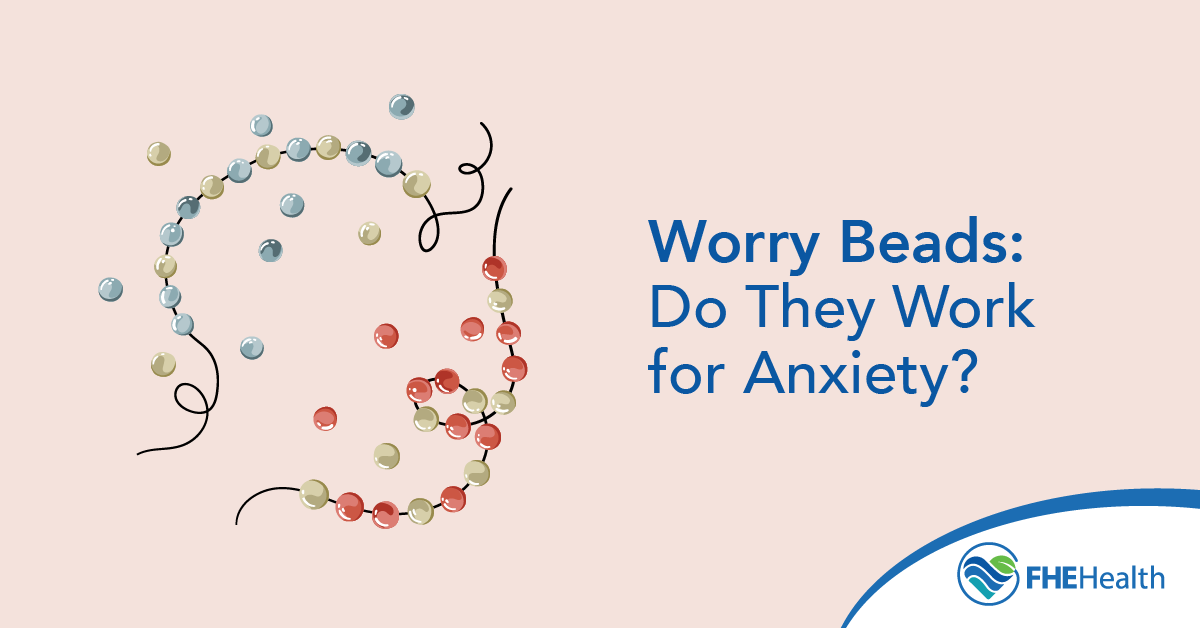
In a world full of high-tech solutions for mental health challenges, sometimes the most effective tools are surprisingly simple. Worry beads — strands of beads manipulated with the fingers — have been used for centuries across different cultures as a way to manage stress and anxiety. Today, these tactile tools are experiencing a resurgence as people seek accessible, discreet methods to calm their minds in increasingly hectic environments.
Whether you’ve seen them referred to as anxiety beads, stress beads, komboloi or fidget jewelry, the basic premise remains the same: a physical object that provides sensory engagement to help redirect anxious energy. But do these simple tools actually work for anxiety management? If so, can learning how to use worry beads be incorporated into a comprehensive approach to mental wellness?
What Are Worry Beads?
 Worry beads are strings of beads for anxiety that are designed to be handled in repetitive motions as a form of stress relief. While their origins trace back thousands of years, different cultures have developed their own variations.
Worry beads are strings of beads for anxiety that are designed to be handled in repetitive motions as a form of stress relief. While their origins trace back thousands of years, different cultures have developed their own variations.
Greek komboloi typically consist of an odd number of beads strung together with a head bead, shield and tassel. Traditionally made from amber, coral or semiprecious stones, these beads were historically used by Greek men as a pastime rather than explicitly for anxiety relief.
Muslim prayer beads, or misbaha, usually contain 33 or 99 beads used for religious recitations, though they also serve a secondary purpose of providing comfort through rhythmic movement.
Modern worry beads come in countless designs, from traditional strings to bracelets, necklaces or even single-piece fidget objects. Materials range from wood and stone to silicone, metal or plastic beads designed specifically for tactile stimulation.
Unlike meditation beads used in formal spiritual practices, worry beads have no prescribed ritual. They’re designed for informal, intuitive use whenever anxiety arises. The beads are typically larger than prayer beads, making them easier to manipulate discreetly with one hand.
Research from the International Journal of Stress Management indicates that 64% of adults engage in some form of fidgeting when anxious, suggesting that tools like worry beads may simply formalize an instinctive human coping mechanism.
How to Use Worry Beads
Learning how to use worry beads effectively is straightforward, with several common techniques employed across cultures. The most basic method involves simply sliding the beads through your fingers one at a time, focusing on the sensation and rhythm. This can be done with the beads held in the palm or by moving them between the thumb and fingers.
The Greek method involves dividing the strand in half and using the thumb to count and flip each bead in a distinctive clicking pattern. The sounds produced become part of the sensory experience, though quieter versions can be performed when discretion is needed.
Some users prefer to roll multiple beads between their palms, creating a massage-like sensation that engages more of the hand’s nerve endings. Others may use the beads as an anchoring object during mindfulness exercises, touching each bead while taking a breath or reciting a calming phrase.
For beginners, experts recommend starting with a simple strand of smooth, medium-sized beads that feel comfortable in your hand. Focus on developing a consistent motion you can perform without looking, allowing the practice to become second nature during anxious moments.
The Psychology Behind Worry Beads
The effectiveness of worry beads isn’t merely anecdotal. Several psychological mechanisms explain why these simple tools can help manage anxiety:
- Sensory focus creates a grounding effect. By engaging the sense of touch, worry beads help anchor attention to the present moment. Neuroscience research suggests that tactile stimulation activates regions of the brain that can help regulate emotional responses.
- Repetitive motion appears to have a self-soothing effect on the nervous system and can lower heart rate and blood pressure in anxious individuals by activating the parasympathetic nervous system.
- Distraction plays a significant role. By giving your hands something to do and your mind something to focus on, worry beads create what psychologists call cognitive load, making it more difficult for the brain to simultaneously maintain anxious thoughts.
- Conditioned association develops over time. Through regular use, the brain begins to associate the feel of the beads with a state of calmness, eventually allowing the mere presence of the object to trigger relaxation.
Can Worry Beads Relieve Anxiety?
While individual experiences vary, worry beads and similar fidget tools can be effective components of an anxiety management strategy. For mild to moderate situational anxiety, worry beads appear most effective. They’re particularly helpful in managing performance anxiety, social unease and general day-to-day stress.
It’s important to note the limitations. For severe anxiety disorders, worry beads are best viewed as a complementary tool rather than a primary treatment. They’re unlikely to provide sufficient relief for panic attacks, post-traumatic stress disorder or clinical anxiety without additional therapeutic approaches.
The beads also work best when used preventively or during the early stages of anxiety rather than during moments of crisis. Regular use throughout the day may help maintain lower baseline stress levels, making it easier to manage anxiety before it escalates.
Other Anxiety Management Tools
While worry beads can be effective for many, they’re just one of many options for anxiety management. A comprehensive approach might include:
- Progressive muscle relaxation techniques that systematically tense and release muscle groups, creating body awareness similar to that achieved with worry beads
- Breathing exercises, particularly diaphragmatic or belly breathing, which directly counteract the shallow breathing patterns associated with anxiety
- Mindfulness meditation practices that develop awareness of thoughts and sensations without judgment, helping break the cycle of anxious rumination
- Cognitive behavioral techniques that address the underlying thought patterns contributing to anxiety rather than just managing the symptoms
- Physical exercise, which research consistently shows reduces anxiety through multiple mechanisms, including the release of endorphins and reduction of muscle tension
- Digital tools like anxiety-tracking apps or biofeedback devices that provide data-driven approaches to understanding and managing stress responses
The most effective anxiety management plan often combines several approaches tailored to individual needs and preferences. For some, worry beads might serve as an entry point to more comprehensive anxiety management strategies.
Finding Your Path to Anxiety Relief
If anxiety is significantly impacting your quality of life, contact us at FHE Health. Our compassionate mental health professionals can help you develop a comprehensive treatment plan that might include traditional therapeutic approaches and complementary tools like worry beads. Start your journey toward better anxiety management today.






